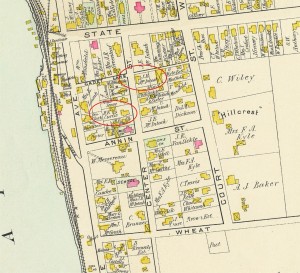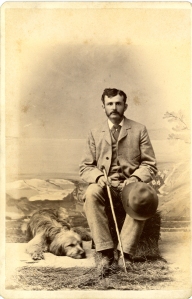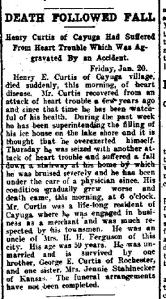A Note to my Readers: I stumbled upon the story of James Patrick, the Missing Grocer, because I was determined to connect my lineage…once again…to my “cousin”, Charlie Baker. Charlie and I became research cronies as a result of our shared great great great grandmother, Lydia H. Titus Downing Coapman and the endless search for her fate. The center of our genealogical universe lies in the little village of Cayuga located at the northeast tip or “foot” of Cayuga Lake. Charlie and I seem to be cousins of a kind through the Titus-Downing-Coapman-Curtis families all of whom settled there in the early 1800’s. I say “cousins of a kind” because I can circle our lineages back to us through several other families…the Titus-Downing-Coapman-Curtis family is the most direct, but Ferree , Hutchinson, Cowing and Dewees all create the unending gene pool that Charlie and I seem to have. So, Charlie, this story is for you and I just know you brush your teeth with Colgate and have a love of Italian food and an ice cold vodka martini.
A Brotherhood of Grocers
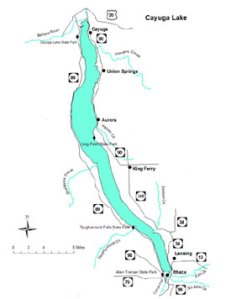
Cayuga Lake Map
Although this story is about James Atchison Patrick, it actually begins with the central New York institution of grocers that populated my Curtis family in the 1800’s. It started with the sons of David and Sophia Green Curtis…Henry Eugene (my great great grandfather) and his older brother, Levi Curtis. The brothers had established a merchant partnership in the 1850’s while they were just in their early twenties. Cayuga and Seneca Lakes were bustling with waterway traffic thanks to the canal systems and the young tradesmen soon had stores on the foot of Cayuga Lake in the village and another at the head of Seneca Lake in Watkins Glen. The men prospered and by 1860 they had added a small hotel in western New York at Caneadea on the Genesee River. In that year New York State was the richest and most populated state in the Union and civil war was brewing.
The call of May 3, 1861, for 42,000 men for three years, authorized committees and individuals by the war department to recruit regiments while the state was engaged in raising the thirty-eight two years’ regiments and by August of that year, both brothers had enlisted as volunteers and left the care of their enterprise in the capable hands of their wives.
Levi distinguished himself in Company F, the 5th Cavalry, NYS Volunteers, fought at Shenandoah and the second battle of Bull Run and after being wounded in battle, the innkeeper from Canaedea, New York was discharged on January 17, 1863 with the rank of Captain.

NY Town Clerks Registers of Men who served in the Civil War 1865 Levi Curtis
Records suggest Henry served in Company F, 136th Regiment Infantry, but there are several Henry Curtises and more than one is a Henry E. which makes proving his service difficult and really unlikely. What is certain is that Henry E. Curtis was registered in Dix, Schuyler county, New York in the 1863 draft as Class II which classified “Salloon Keeper” Henry E. Curtis as a married man between the ages of 36-44.

1863 Draft Registration Dix NY H E Curtis
At the end of the war, Levi and his Michigan born wife, Lurana Ellsworth, moved to Fenton, Genesee, Michigan to live with their married daughter, Mrs. Edwin (Charlotte) Trump and to enjoy the company of their infant granddaughter, Minnie.
Henry Eugene Curtis and his wife, Susannah Downing, and their three children, Helen “Nellie”, Henry Eugene, Jr., George Downing (my great grandfather) and little Jennie L. was not to stay whole long as Henry died in Watkins Glen at the age of 44 in 1866…little more than one year after the conclusion of the Civil War.

The Corning Journal Thu 4 Oct 1866
Levi, too, died young…in 1868 at the age of 49 at his son-in-law’s home in Fenton, Michigan. A Death Notice in the Michigan Fenton Independent 22 Apr 1868 reports…
CURTIS, LEVI, ae 50y, at residence of his son-In-Iaw, Edwin Trump, in Fenton, Mich. Fentonville Lodge No. 109 3 June 1868 passed resolution: “Levi Curtis, late of Belfast, N.Y., formerly member of Chemung Lodge…”
The Curtis brothers who had a small and vital merchant empire along the New York Canal system in the heyday years before the War of the Rebellion lived long enough to know the embrace of family but not long enough to regain their spirited life of entrepreneurship.
A Safe Place to Fall
Susannah sold the store in Watkins Glen upon Henry’s death in 1866 and moved her family to the village of her birth…Cayuga. Her twice widowed mother, Lydia Titus Downing Coapman, was still living in the village as were her siblings, Mary Jane, Phebe and George Henry Downing and half brother, David Sands Coapman. With the support of the Titus and Coapman families, the 34 year old widow settled into her Aurelius home to raise her children and live out her life.
In four years the siblings had acclimated to life in their mother’s birthplace and indeed the oldest child, Nellie, had fallen in love and married Christopher French Parcells, the dashing young son of Maria French and Joseph Jerome Parcells, a well loved and well travelled preacher who was born in Cayuga in 1822. The Parcells owned one of the first stores in the village…located across the street from the Titus House. The Titus house was established by my great great great grandmother Lydia H. Titus Downing Coapman’s brother, David Sands Titus.
Henry Jr. became the man of the house long before he reached manhood. It wasn’t long before he was well known among the village residents for his good work ethic and his good nature. From the start he was a “hardy” fellow and a strong support for his mother. Susannah continued to live with her son, Henry, as did his siblings until they married. In fact, life long bachelor Henry cared for his mother until her death in 1893. Sister, Nellie M., left the village home when she married Christopher Parcells in 1872 and they moved to Auburn. My grandfather, George, left when he married Kate Curry in 1879 and they moved to Port Byron. The youngest, Jennie, was the last to leave when she married John Stahlnecker in 1880 and they moved west to the Minnesota Territory.
We have reached the point where we can introduce…..
The Main Players in the story of the Missing Grocer from the little Village
Nellie M. Parcells
Nellie M. Parcells was born in 1875 in the city of Auburn-the second daughter of Nellie Curtis and Christopher Parcells. Her father was a well known pharmacist and for most of his life owned and operated his store on 29 Grant Avenue. Nellie and her siblings, Anneka, William and Hortense had a happy and socially connected life. When her mother died unexpectedly in 1890, her father soon remarried to Alyce Dewey who was 27 years younger than he and proceeded to have four more children-: George Dewey, Marguerite, Henry Curtis and Guy Alton Parcells. The Parcells household was full of music, family and friends and was an altogether agreeable environment. The only spoiling moments were the tormenting bouts of malaria that plagued Christopher.
As a young man, Christopher had spent time in and around the swamps of Montezuma…which were a haven of mosquitoes and I suppose that might well have been the source of his disease.
James Atchison Patrick
James Atchison Patrick, son of John Patrick and Jesse Nisbet was born in Ontario, Canada on December 9, 1877. James and his parents left Canada and moved to Milo, Yates County, New York when he was just a toddler. They had two more sons, William J. and Clarence, and had moved to Auburn by 1890 where the Canadian saddle maker bought a home on 96 Owasco Road and set up shop where he invented the Patrick Horse Collar. Jesse died in 1893 when she was just 34 leaving John with three boys under the age of thirteen. In 1895 in Mount Blow, Ontario, Canada, he married fellow Canadian, Agnes Jameson, a young widow with a son. Agnes and her son had lived in Auburn several years before the Patricks so it appears they went to Canada to marry and immediately returned to Auburn to raise their boys together at their home on Owasco Road.
The late 1890’s finds James working at the McConnell Dry Goods Store on Genesee Street as a salesman and living as a boarder at 29 Grant Avenue where he met Nellie Parcells. Nellie and James married when they were 19 and 17 respectively. In December of 1896 they welcomed daughter, Christine Beatrice and less than two years later, son, Curtis Atchison Patrick arrived. By 1905 James and Nellie were living in Throopsville, NY and in 1910 he was a working as a poultry farmer in Aurelius.
And then in 1911 Nellie’s favorite uncle…Henry Eugene Curtis… died. Henry had property in several areas of Aurelius and owned the country store in the village of Cayuga…his favorite haunt …where folks came from all over to buy their goods…but especially to pass the time with the now rotund and ruddy shop owner. Henry died a very financially secure bachelor and his nieces and nephews were all well remembered in his estate. In 1911 the bustling store became the property of Nellie and her husband, James. They moved to the village and began “keeping shop”. James bought a boat and named the white motor boat “The Christine” after his daughter.
And on August 5, 1917, 39 year old James Atchison Patrick disappeared.

States He Saw Missing Man In Ithaca Monday
The Disappearance
When the little white boat was found bobbing off shore near Ludlowville the following day, the alarmed family began the frantic search. The word went out up and down the Ithaca-Auburn Shortline- the railroad line that followed the lake shore to the city of Ithaca. The newspapers were filled with the alert for James Patrick and the authorities prepared to drag the deep waters of Cayuga Lake. James’ brother, Clarence, who by now was a successful plumber and prominent citizen of Auburn, led the search. On August 7, an Ithaca man named George Taylor, an acquaintance of James Patrick and soliciting agent for the Shortline, reported that he had had a conversation with Mr. Patrick. James had boarded the Shortline at Ludlowville and had casually told Mr. Taylor that he was on his way to “do a little swapping”. His demeanor was casual and quite normal according to Mr. Taylor. Sheriff Lyman Gallagher and his deputies combed the city of Ithaca, but James Patrick was nowhere to be found.
For five years, Nellie and her son, Curtis and James’ brother, Clarence searched for James through several states and sightings and into Canada where the Patrick family had relatives in Ontario. Christine….the namesake of the merry little white boat her father had abandoned in August of 1917…married George Eugene Ferree, a young farmer from Aurelius. The marriage would produce one child, Barbara Jean Ferree. By 1918 the mortgage for the property in the village was foreclosed and Nellie and her son were left to pick up the pieces. James had left the once thriving store in financial ruin.
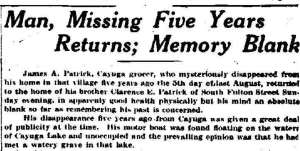
Man Missing Five Years Returns: Memory Blank
The Prodigal Son Returns
And then on Sunday, October 15, 1922 “the mystery surrounding the sudden and strange disappearance of James A. Patrick from the quiet little village of Cayuga” was “ partially resolved by the return of Patrick to the home of his brother, Clarence Patrick in South Fulton Street”. James had arrived that Sunday night “tired out from a long ride from Louisville, Ky.” He was examined by a physician and found to be fit “but his memory is a blank except for matters of the immediate present.”
When questioned, he stated that he had no memory of leaving Cayuga or why or of places he had been in the past year. According to James, while in Louisville someone mentioned the name of “Patrick” and the name “Auburn” and James had a sudden recall of his brother so he started out immediately for Auburn and the home of his brother, Clarence.
Now forty-six and apparently with no memory of a wife or children or family members…including his father and brothers, Nellie and her children were brought to the home to attempt to recover his memory. Upon his return, James had made his home with his brother at the advice of their physician. Whatever memory he did recover evidently did not ever include Nellie, Christine or Curtis.
Nellie Moves On
Despite the continuing search for her husband, Nellie had managed to take her monetary inheritance from her Uncle Henry and with what little she received after her father’s death-remember there were many siblings-she kept her home in the little village. She gathered up her still devoted and grown, unmarried son, Curtis…and divorced daughter, Christine, and granddaughter, Barbara…and bought a small ice cream shop in Florida. She had become a well known travel expert…perhaps in her five year long search for James…and headed a travel association to encourage New Yorkers to “winter” in Winter Haven, Florida.
Barbara Jean Ferree became quite the little traveler and was reported to have taken the train to Auburn from Florida when she was just 12…visiting her Parcells and Ferree family members. Barbara married her Auburn sweetheart, William H. Staat at the little Sand Beach Church at the head of Owasco Lake in 1946. No mention of her father was made in the wedding festivities. Her brother escorted her down the aisle.
I could not find out what happened to James for quite some time. Indeed I just thought he died alone as he was never mentioned again in social notes despite the continuing and merry gatherings at Clarence Patrick’s home. The last mention I had of James was in 1933 when his father, John, passed away. “living in Cayuga”, it said. The little village where the mystery started…where Nellie still owned her uncle’s home…but where she did not live again.
Nellie M. Parcells died in Auburn on May 7, 1962. Her obituary reads “Mrs. Nellie Patrick Dies in Hospital”. Nellie was 87 years. And her obituary states she is the widow of James Patrick. The logic goes that her surviving family provides the obituary information and so I began to search for James’ resting place. Did they reconcile…forgive…forget…accept? Nellie is buried in the Parcells plot in Soule Cemetery and there is no James Patrick there. UPDATE: When I was contacted recently by Nellie’s great granddaughter, she told me that Nellie divorced James Patrick. She writes:
Nellie Patrick filed for divorce from James Patrick and it was granted after 7 years of abandonment, as was the law back then. I’m sure the word “widow” was used by the undertaker in Auburn for the obit and not by anyone in the family. My grandmother, Cristine Patrick Ferree told me at one time when I was looking over her family genealogy papers, that she had been invited to go fishing with her father that fateful day in 1917, but she wanted to stay home and wash her hair instead(possibly she had a date that night with George Ferree, whom she married 2 months later). She always felt guilty that she didn’t go with him and perhaps could have prevented whatever happened.
Did he disappear? Again?
A Canadian Moment
And then…I had a “Canadian moment”…might have been the bacon I had for breakfast. Whatever.
So back I went to Ontario, Canada research and there it was…..James A. Patrick was James Atchinson (sp) Patrick. The game was afoot. I never found his World War I draft registration…don’t forget he disappeared on the very day that draft registration took place in central New York…could that have been another strain on his already distressed mind? But then I tweaked his middle name as all genealogists know…what’s in a name? So taking poetic license…thanks Will S….I researched James Atchison Patrick.
There in 1942 in Fairfield, Ohio on the KENTUCKY border is James Atchison Patrick, born in Brant, Ontario, Canada on December 9, 1877 …and married. To widow Alma Smith. To someone who is not Nellie.
After Alma died in 1944, he married a third time to a woman named, Grace Leota.
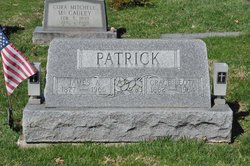
James A Patrick Monument
And there he died in 1965…three years after Nellie. He is buried next to Grace Leota in Forest Rose Cemetery in Lancaster, Ohio.
Questions Questions Questions….
At some point…did James return to Kentucky with the knowledge that he was married to two women? Was he a grocer again? And with only the memory of one wife and not the mother of his two children…are there children with “that” Mrs. Patrick? Did he stay in Cayuga because Clarence wanted him to find his old life only to give it up and go to the wife he remembered? And is that why when Clarence died…he was not listed as a surviving brother along with William? Did he just want to start over? Or did he really suffer from a form of amnesia called retrograde or dissociative?
During this research I came across a family member of Alma Smith – her grand nephew. So I did it…I asked the question and hit “send”. What did he know about Mr. Patrick? Turns out James was not a “talker” and they never met any of his family. James never spoke of them. And they never knew he had been married before. “A nice enough fellow.” And Alma was Canadian…lived in Kentucky with James with her Canadian born family members…who happened to be from Brant, Ontario, Canada. Gently, gently, I closed that door….and let James Patrick disappear…again.
Deborah Martin-Plugh
Author, Historian and Genealogical Researcher
(c) Copyright 2010. All Rights Reserved
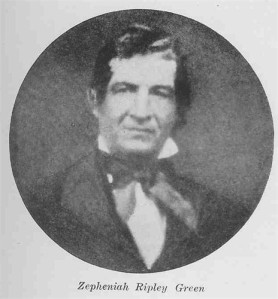 what fun. The given names were a poetic blend of biblical and historical. Zepheniah Ripley, Aurelia and yes…Speedy Greene! I love Speedy Greene! Speedy married Scotsman Gerothman McDonald and they had eleven children of their own…with some pretty spiffy names. Gamaliel Barstow and (this one rolls of the tongue)…Beebe Galusha McDonald. A lively and celebrated family from Livonia, Livingston county, NY.
what fun. The given names were a poetic blend of biblical and historical. Zepheniah Ripley, Aurelia and yes…Speedy Greene! I love Speedy Greene! Speedy married Scotsman Gerothman McDonald and they had eleven children of their own…with some pretty spiffy names. Gamaliel Barstow and (this one rolls of the tongue)…Beebe Galusha McDonald. A lively and celebrated family from Livonia, Livingston county, NY.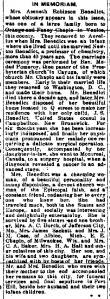 The last Asenath I found was Asenath Robinson Chapin Benedict (1831 -1900). She was the daughter of Orange Chapin and Fanny Greene and born in Venice, Cayuga county, NY. Her memoriam in the Auburn NY Democrat, was her gift to me…her first cousin, 4 times removed. A grand life, well spent and a tribute to the earliest Cayuga County pioneers.
The last Asenath I found was Asenath Robinson Chapin Benedict (1831 -1900). She was the daughter of Orange Chapin and Fanny Greene and born in Venice, Cayuga county, NY. Her memoriam in the Auburn NY Democrat, was her gift to me…her first cousin, 4 times removed. A grand life, well spent and a tribute to the earliest Cayuga County pioneers.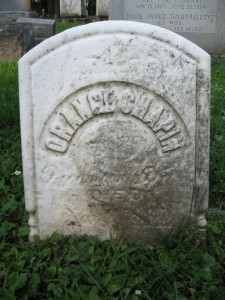
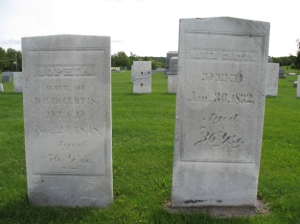 Sophia Greene Curtis is buried beside her husband, David Curtis in Oakridge Cemetery in Livonia, Livingston county, NY. Oakridge, too, is the site of burials for a great number of ancestors including the wonderful Speedy Greene McDonald and her descendants.
Sophia Greene Curtis is buried beside her husband, David Curtis in Oakridge Cemetery in Livonia, Livingston county, NY. Oakridge, too, is the site of burials for a great number of ancestors including the wonderful Speedy Greene McDonald and her descendants.

